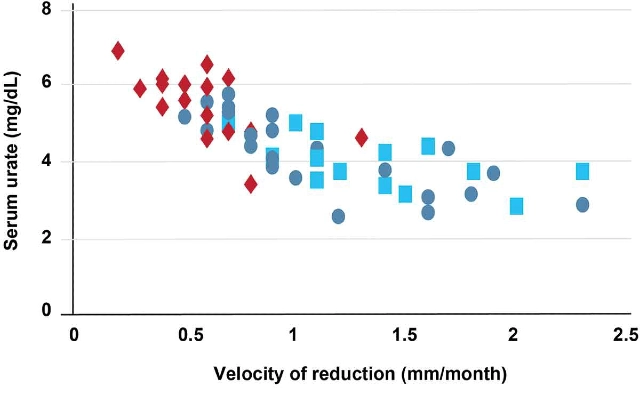This is my review of a uric acid treatment study. In which I will explain the key points for gout patients. So this is for people who are concerned about uric acid management. Because it explains the importance of patient education. In the hope that you can support your doctor’s treatment plan to achieve safe uric acid targets.
Citation for Target Uric Acid Below 6 mg/dL
This is a GoutPal review of:
Ruoff, Gary, and N. Lawrence Edwards. “Overview of serum uric acid treatment targets in gout: why less than 6 mg/dL?.” Postgraduate medicine 128, no. 7 (2016): 706-715.
At the time of writing, this study has been cited by 24 other studies.
Target Uric Acid Below 6 mg/dL Purpose
The purpose of this study is to explain why uric acid in gout patients needs to be reduced below 6 mg/dL. Rather than the common target of “normal”:
[uric acid in the blood] level in what an individual laboratory considers the ‘normal range’ may still reflect levels in joint tissues that are above the point for MSU crystal formation
Jargon-free Abstract
In the jargon-free abstract I present the key points of the original abstract. Replacing jargon with terms more familiar to unqualified people interested in gout. Note that my selection of jargon terms might not match yours. So please ask in the feedback form near the end of the page if you need clarification.
- Background / Introduction
- Gout is progressive. So without adequate uric acid control it leads to lumps of uric acid crystals and damage to joint structures.
- Methods
- The authors searched for studies concerning many aspects of gout management. Including some recommended guidelines. Then they reviewed the outcomes.
- Results / Findings
- Treating to a target below 6 mg/dL is effective. But doctors must adhere to treatment guidelines. Also, patient education is important to improve compliance.
Original Abstract
Gout is a progressive, painful, debilitating form of inflammatory arthritis. It is caused by factors that elevate the concentration of serum uric acid (sUA), leading to hyperuricemia (sUA >6.8 mg/dL). Continued elevated sUA can result in monosodium urate (MSU) crystal deposition in joints and soft tissues, and can cause acute and chronic inflammation. The prevalence of hyperuricemia and gout has increased over the last few decades, likely due to an aging population, changes in lifestyles and diet, and an increase in gout-associated comorbidities. Untreated or improperly treated gout can lead to chronic manifestation of the disease, including persistent inflammation, increased number of flares, development of tophi, and structural joint damage. Data show that even when patients are asymptomatic, ongoing inflammation and subsequent damage occurs locally at the joint and systemically. The aim of long-term treatment of gout is to reduce sUA levels to gout is a curable disease.
Target Uric Acid Below 6 mg/dL Conclusions
For gout recovery, uric acid must be reduced below 6 mg/dL.
British Society of Rheumatology recommends the lower (

For email notifications when I publish more study reviews here, please subscribe to this website:
Subscribe to Free GoutPal Links
Subscription is free, and your email address is safe - I will never share it with anyone else. I use Gumroad to provide this service, as described at GoutPal Links Newsletter Service.
Leave Target Uric Acid Below 6 mg/dL to read Gout Library Home Page.
Target Uric Acid Below 6 mg/dL Vocabulary
-
hyperuricemia
⇢ high uric acid
-
MSU (MonoSodium Urate)
⇢ uric acid (usually crystals) bonded with sodium and water molecules.
-
sUA (serum Uric Acid)
⇢ uric acid in the blood
-
tophaceous
⇢ having, or related to lumps of uric acid crystals (see tophus)
-
tophus (plural = tophi)
⇢ lump of uric acid crystals
Common Terms: hyperuricemia, MSU (MonoSodium Urate), sUA, tophus (plural = tophi)